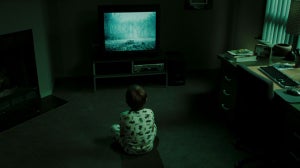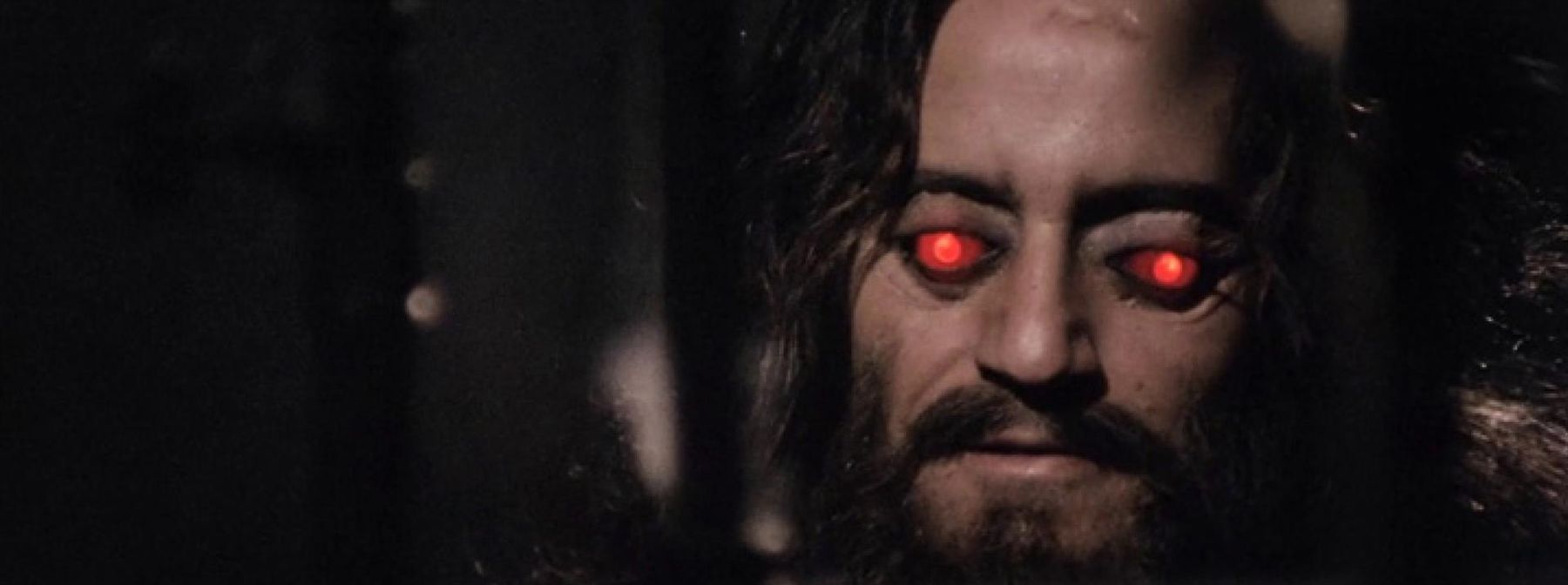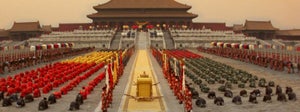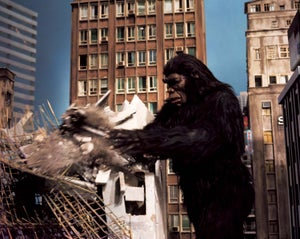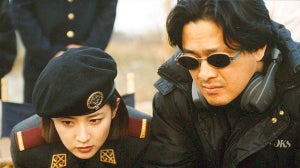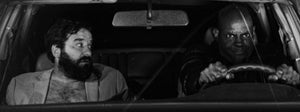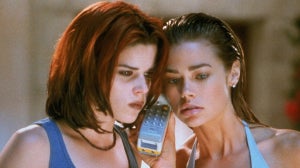
“You might say that a filmmaker can use a telephone booth in the same way a novelist uses a blank piece of paper.”
Alfred Hitchcock, as told to François Truffaut
It's long been a rule of thumb for independent filmmakers that, when shooting on a low budget, planning a film around a single location is often advisable. One of the principal costs on any film shoot is time, and moving an entire cast and crew from place to place eats up a significant amount of it. And while there's always a risk that confining a story's action to one setting can make a film feel overtly theatrical, this is a restriction that genre movies can frequently turn to their advantage; what might feel stagy in a straight drama can help create a sense of isolation and claustrophobia in a horror film.
Patrick Picard's film The Bloodhound is an excellent example of this approach, taking a solitary country home as its setting and turning it into a psychological battleground. So, to mark Arrow's upcoming release of The Bloodhound (on Blu-ray March 22), here's a look at some other seminal single-location genre movies. We've tried to mix it up a little; you'll find a selection of Arrow classics here, but also some deeper cuts...and while, as you might expect, there are certainly one or two haunted houses on the list, who says your single location has to be a house? Why not a car, or a train, or as Hitchcock suggested, even a telephone booth..?
Isle of the Dead (Mark Robson, 1945)
One producer entirely accustomed to working on restrictive budgets was Val Lewton, and although many of his films appear far more expansive in scope than their final costs might suggest, one of the occasions upon which he did restrict his story to a single location was Isle of the Dead. Set during the Balkan Wars in 1912, the film strands its cast on a Greek cemetery island during an outbreak of septicemic plague (its recurring scenes of obsessive handwashing and characters being too afraid to touch each other having acquired a queasy contemporary relevance), where they can do nothing but wait to see who will live and who will die, while also being terrorised by Boris Karloff's tyrannical army general and, perhaps, a vampiric creature known as a vorvolaka. Subtly creepy even today (Martin Scorsese has said that when he first saw the film, he “ran out of the theatre before the end because it scared me to death”), and notable for its melancholy tone and atmosphere of quiet morbidity, Isle of the Dead uses its cemetery setting to symbolically suggest that, ultimately, we are all just waiting around to die.
https://www.youtube.com/watch?v=e3atJxdNJGc
Daughters of Darkness (Harry Kümel, 1971)
Stanley Kubrick's The Shining is not on this particular list, but the other great horror movie set almost entirely in a hotel is undoubtedly Daughters of Darkness. Much as Kubrick's film does, Daughters of Darkness takes a small cast and isolates them in an eerily empty grand hotel; however, while The Shining's characters find themselves marooned by a snowstorm, Kümel's cast of lost souls could escape at any time, but simply have nowhere else to go. Some films employ their single location to foster a sense of claustrophobia in the audience, but Daughters of Darkness instead uses the vast ballrooms and long deserted corridors of its hotel setting to build a terrible atmosphere of loneliness. The faded decadence of the locale perfectly mirrors the vicious lusts of the characters, for the style of Kümel's film is the substance. Location, décor, costume; all work in tandem to demonstrate the dreadful, destructive allure of beauty.
https://www.youtube.com/watch?v=DYEKxAtcA8M
Horror Express (Eugenio Martin, 1972)
The first of two adaptations of John W. Campbell's novella Who Goes There? on this list (albeit an extremely loose and uncredited one), Horror Express preserves the wintry atmosphere of the original story but relocates the events onboard the Trans-Siberian Express. Christopher Lee's anthropologist discovers a frozen humanoid in a Manchurian ice cave, and believing it to be the missing link, attempts to ship it back to Europe. But the preserved specimen turns out to be the host for an alien life force, which proceeds to infect a succession of passengers in a bid to escape. Horror Express eschews the gnawing paranoia of the source material – we always know who the alien is, even if the characters don't – and opts instead for outright action and suspense, an approach which it pulls off brilliantly, holding up far better today than many of its creakier gothic contemporaries. Above all, the film's secret weapon is perhaps its sly sense of humour; some of the dialogue is still laugh-out-loud funny almost fifty years later. And while the pseudo-science on display admittedly errs on the side of being unintentionally comic, Horror Express deftly rights the balance with several effectively mounted scenes of outright horror – the climactic massacre of an entire platoon of Cossack soldiers, only for them to be immediately revived as white-eyed zombies, is genuinely nightmarish.
https://www.youtube.com/watch?v=rvedYIHHlHY
La Cabina (Antonio Mercuro, 1972)
Famous amongst a generation of schoolkids as a weirdo foreign film that mysteriously showed up on late night TV and scared the hell out of everyone who saw it, La Cabina was once almost impossible to see, but is now available in a restored version on YouTube. Running for little more than half an hour, Mercuro's film tells the story of a man who unaccountably finds himself trapped in a telephone box (nicely proving Hitchcock's point). A crowd of people slowly gather around him to watch, but despite the best efforts of several would-be samaritans, no one can quite manage to free him. From there, La Cabina progresses from a sort of surreally grim comedy to outright nightmare. It follows no particular train of logic, preferring to keep its horrors inexplicable, and isn't greatly interested in exactly who the trapped man is as a person. He's just a hapless everyman, and perhaps, in the end, Mercuro is simply telling us what life in Franco's fascist Spain was like for many such people: sunny and idyllic one moment, only to find themselves abducted, imprisoned, and tortured the next.
https://www.youtube.com/watch?v=c_-A7XjFsqQ
Rabid Dogs (Mario Bava, 1974)
An acknowledged master of the gothic form, Mario Bava is perhaps not always given credit for just how versatile a director he was, and there is no better evidence of this than his 1974 masterpiece Rabid Dogs. Completely casting aside the stylish cinematography and coloured lighting that was his trademark, here Bava utilises nothing but the unforgiving glare of a brutally hot summer's day and a sweatily intimate handheld camera to tell his story of three crooks and their hostages on the run together. Aside from the opening heist sequence, the majority of the film unfolds inside a single car interior, one of the best-sustained pieces of claustrophobic filmmaking I've ever seen. Bava places the audience squarely inside that boiling, airless vehicle, the monstrous criminals continually cackling and leering right in our very faces. While not quite a horror movie, Rabid Dogs is unflinching in its sheer nihilism, and is certainly a cousin to the sort of scumbag cinema popularised by Last House on the Left. But unlike so many of the other Italian imitations of Wes Craven's film, Rabid Dogs never feels gratuitous or exploitative. It's just a living hell, one we're trapped in alongside the characters.
https://www.youtube.com/watch?v=Mm0jHfuchr0
Burnt Offerings (Dan Curtis, 1976)
Although little-remembered now, Robert Marasco's 1973 haunted house novel Burnt Offerings was an acknowledged influence on Stephen King's The Shining, telling the story of a family who rent a bargain-priced summer home from hell and soon begin to lose both their minds and their lives as a result. Similarly, Dan Curtis's 1976 adaptation of the novel is often overshadowed by Kubrick's version of The Shining, but while not as grandly virtuosic as that film, it's a grimly effective chiller with a nasty sting in its tail (not to mention a closing shot that is practically stolen outright by Kubrick). Oliver Reed does his red-faced, eye-rolling best to set the pace for Jack Nicholson's similarly-unrestrained Shining performance, Karen Black goes quietly crazy as only Karen Black can, and while there's a paucity of actual ghosts in Burnt Offerings, the one apparition we do see is still capable of raising the hairs on the back of the viewer's neck. Marasco once said in an interview that he originally intended his book to be a black comedy, but “it just came out black”. Curtis's film likewise doesn't pull any punches; it's a snapshot of the American Nightmare, and ends on the sort of bleakly-devastating note that only 70's genre movies can.
https://www.youtube.com/watch?v=Q6iChx9TvXQ
The Thing (John Carpenter, 1982)
Perhaps the big daddy of single-location horror movies, The Thing (the second, this time official, adaptation of Who Goes There? on this list) is John Carpenter's most fully-achieved film, matching his filmmaking artistry with a perfectly-realised vision of cosmic dread. The director has often spoken about his theory of “right-wing” and “left-wing” genre movies, suggesting that right-wing films position the central threat as coming from without; a force that humanity must band together against (Carpenter had already worked in this mode in films like Assault on Precinct 13 and The Fog). However, left-wing horror is more insidiously subversive, locating its horrors within our own selves. The Thing is one such work, and its unsparingly paranoid vision of an isolated group of men being pitted against each other makes it a worthy addition to this lineup. What is also noteworthy about Carpenter's film is the sheer level of craft behind it; it's true to say that the director is probably the best out-and-out technical filmmaker of his genre peer group. Of particular interest is his habitual use of the widescreen 2:35 frame, the only film on this list to utilise the format. In a single-location scenario, many directors would avoid widescreen, preferring instead to keep the frame cramped and claustrophobic (indeed, the last film selected here goes to the very opposite extreme). But Carpenter understands the different uses the format can be put to, either isolating his characters in the wider frame to emphasise their loneliness and terror, or else clustering them uncomfortably together in groups, heightening the sense of distrust and paranoia festering amongst the men. It's just one of the many reasons The Thing is an enduring masterpiece.
https://www.youtube.com/watch?v=czqSL4TvLzk
Session 9 (Brad Anderson, 2001)
Restricting a film to a single setting is obviously less of an imposition on the filmmakers if said setting happens to be both visually striking and entirely out of the ordinary. That is certainly true of the central location of Session 9: the derelict Danvers State Mental Hospital, a vast 19th century asylum located in Massachusetts. This is a film in which setting and story are inextricably linked; Session 9's script was developed with the Danvers Hospital in mind, and one imagines it might have been almost impossible to shoot it anywhere else. So imposing is the location that it's quite feasible a far less talented cast and crew would still have managed to wring sufficient atmosphere out of it to make for a passable film, but luckily the filmmakers behind Session 9 were creative enough to fully utilise its potential. Anderson's film positively drips with slow-burn dread, and even when nothing in particular is happening onscreen, the looming backdrop is so unsettling in and of itself that it hardly matters. Add to that a cast of heavyweight actors such as Peter Mullan and David Caruso, an intelligently-layered script, and you have a recipe for a horror film that, by the time it reaches its shattering climax, is not only extremely frightening, but also deeply tragic.
https://www.youtube.com/watch?v=fFUU2oAWJm0
Queen of Earth (Alex Ross Perry, 2015)
Much like The Bloodhound, Queen of Earth is an independently-made psychological horror movie, much of it playing out as a two-hander in a single house, and demonstrates that such limited means need not limit the ability of filmmakers to tell wildly different stories. Whereas The Bloodhound is coolly, stylishly cerebral, Ross Perry's film is raw and emotional, opening with a character's psychological breakdown and going on to plumb even deeper depths from there. The set-up is simple: two friends (played by Elizabeth Moss and Katherine Waterston) travel to an idyllic lakehouse to spend some vacation time together. Moss's character is already traumatised by a recent breakup and the death of her beloved father, and the trip is intended to help her recover. Instead, she continues to unravel, and it is left to us to judge whether Waterston and others are conspiring to nudge her into madness, or whether that perception is simply the product of her own burgeoning paranoia. Queen of Earth is explicitly influenced by several other works that could easily have been on this list: Roman Polanski's apartment trilogy (Repulsion, Rosemary's Baby and The Tenant), Ingmar Bergman's chamber psychodramas (Persona, Hour of the Wolf) and John Hancock's Let's Scare Jessica to Death, and is similarly rooted in nakedly powerful performances from its central cast members. Also like them, it is unafraid to spend its entire running time gazing unblinkingly at a human being slowly losing their mind; perhaps the greatest horror of all.
https://www.youtube.com/watch?v=lzPgN8eEI-c
The Lighthouse (Robert Eggers, 2019)
So we come to the most recent film here, a studiedly retro work which almost feels as though it might date back to before any of them. After only two movies, Robert Eggers is already notorious for his fastidious attention to period detail, and refusal to employ any of the technological short-cuts available to the contemporary filmmaker. Most notable is the film's nearly square aspect ratio, the absolute antithesis of John Carpenter's favoured widescreen format. Reasoning that, due to its titular locale, The Lighthouse needed to be a vertical and not horizontal film, Eggers also decided that the ratio helped “make the movie look old”, thus augmenting the story's period setting, as well as being “better for conveying cramped interiors and claustrophobia”. And while the director's disavowal of modern technology certainly doesn't render The Lighthouse uncinematic (the film's use of visuals, sound design, and music is often stunning), in other respects Eggers does lean into the staginess that can arise from the use of a single location. Heavily dialogue-driven and influenced by the works of playwrights Samuel Beckett and Harold Pinter, it's quite possible to imagine The Lighthouse being adapted as a play. And yet, when you have performances as physically and psychologically committed as the two central ones here, and a script that is as bleak, funny and beautifully written as this (Willem Dafoe's stunning Triton monologue is a particular highlight), why quibble over so-called theatricality? The Lighthouse serves as a final illustration of just how many different ways an inventive director can choose to employ a single setting, and it and the rest of the films on this list are proof of the fact that genre cinema can not only succeed in spite of such restraints, but thrive because of them.
https://www.youtube.com/watch?v=Hyag7lR8CPA
For the latest from Arrow Films, follow us on Instagram, Twitter, Facebook, and YouTube.

Related Articles
